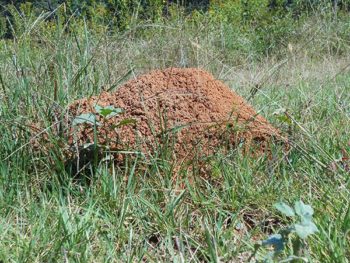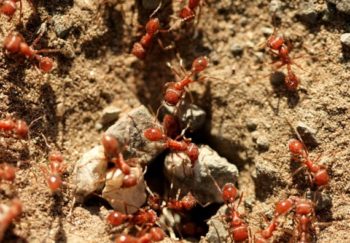GREEN AND GROWING
Help! I’ve Got Ants

Fire Ant Mound
This may not be a bad thing. Ants are both predators and prey. They eat the eggs of many insect pests and serve as food for birds, lizards, and other beneficial critters. Their tunnels aerate the soil as much as earthworms and allow water and nutrients to flow directly to plant roots. They are an important seed dispersal mechanism for many wildflowers. Finally, an active and varied ant population may help control an infestation of imported fire ants.
For all these reasons, a wholesale campaign to eradicate all ants is not a good idea.
But some ant species can be a nuisance or worse in the garden. Ants in the vegetable garden often “herd” colonies of aphids and other sucking insects in order to cultivate their secretions of a nectar-like substance known as “honeydew.” (In these cases, I recommend controlling the aphids and leaving the ants alone.) Nonnative red imported fire ants raise large mounds in lawns and can deliver extremely painful and numerous bites. Some folks may have a life-threatening allergic reaction.

Fire Ants
The first step in the control of imported fire ants is proper identification. No all ant mounds host fire ants. Adult red imported fire ants are reddish to dark brown; sometimes they are red and brown. The workers are either about 1/8 or ¼ inch long. This means that the ½” long red or black ants you come across are not fire ants. Neither are tiny sugar ants. Imported fire ant mounds are typically constructed in open, sunny areas. Mounds constructed in clay soils are usually symmetrical and dome-shaped. Foraging workers exit the mound through a network of underground tunnels that may extend 100 feet or more from the central mound. There often are no visible exits or entrances on the mound above ground, and this can be a diagnostic sign.
Eradicating fire ants is difficult and, in many cases, impractical. Control is often the best a homeowner can hope for. Unfortunately, there usually is no effective alternative to chemical insecticides. (I’m sorry, but grits do not work.) There are two basic approaches to chemical control: an insecticide that can be applied to individual mounds or one that is bound with an attractive bait and broadcast over a wide area. Individual mound treatments are more environmentally benign because they have a lesser impact on non-target insects, including other ants. Broadcast treatments can result in an ant community changing from one that is dominated by native ants to one dominated by imported fire ants. Individual mound treatments further subdivide into liquid drenches and granular baits. Regardless of the method chosen, always follow the label directions when applying any fire ant insecticide.
The most effective method of applying ant insecticide to an individual mound is to place bait around a mound and wait 5-7 days. Then apply a mound drench to finish off the remaining workers.
The active ingredient in ant baits are rapidly degraded by high temperature, high humidity, and intense sunlight. The baits can be rendered ineffective in a few hours by these conditions. Likewise, the food element of the bait must be attractive to the ants, so the bait must be fresh. Old bait will not attract the ants.
Tom Watson
Tom Watson is a Volunteer Extension Master Gardener in Mecklenburg County. He has also received a Certificate in Native Plants from UNC-C and a Certificate in Horticulture Technology--Residential Landscape Design from CPCC. He and his wife, Sue Bartlett, own The Cedars Davidson Bed & Breakfast.


